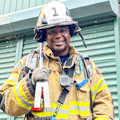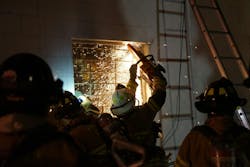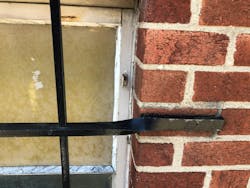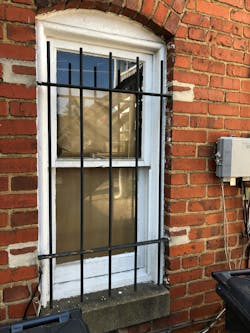Window Features: Burglar Bars & Screens
Window bars, which also are known as burglar bars, go back to the 1800s, when stores began to use them to cover windows to protect their goods but still allow people on the street to see their wares. As crime began to soar, burglar bars carried over to residences, particularly on the ground level. As time passed, the installation of burglar bars became more noticeable in urban areas of lower household incomes and higher crime rates and that contained businesses that sell expensive products.
As much as burglar bars are a deterrent to people who try to get in, they became problematic for people who try to get out in emergency situations, for both civilians and firefighters.
It’s important to understand numerous things about burglar bars and how they play a role in the fire service, including their construction, how they are affixed to structures and buildings, how firefighters remove them and how firefighters train to deal with them.
Construction
Many burglar bars used to be made by local metal fabricators, using cast iron or steel. Today, burglar bars can be made commercially and even bought at hardware and home stores.
The type of metal can vary, but the common denominator to all burglar bars is that they are strong, and, so, a lot of energy and force is required to remove them. Burglar bars usually span the entire width and length of a window, with some kind of attachment point.
Over the years, some people began to dislike burglar bars’ prison-looking, vertical-bars-with-horizontal-bars design. As a result, burglar bars became more decorative, including via the use of swirls and other shapes in the metal. These models don’t look as aggressive but still provide the same protection.
Three types of attachments
Attached to brick. One of three main ways that burglar bars are affixed to the structure or building is attached to the brick. Usually, all four corners of the bars have a small, welded metal tab that’s pressed flat against the brick. A carriage bolt is inserted through the tab and into the brick.
Built into brick. The second way that we find burglar bars affixed to the structure or building is built into the brick. In this configuration, the metal tabs are flat, too, but in between the mortar of the bricks. When the mortar dries around the tabs, they’re secured within the row of bricks.
Frame-recessed. With this third option, the burglar bars usually are set inside of a frame. That frame then is set and secured in the window frame. Many times, these barred frames have some kind of caulking or paint around them, so they aren’t an eye sore.
These three setups are common to installation on both residential structures and commercial buildings.
Wire screens
There can be an argument as to whether burglar bars or wire screens provide the better view to the exterior for the occupant. However, wire screens provide the same protection as burglar bars.
Most wire screens are recessed within the window frame. Some of them are hinged, and this construction can serve as a “door” because of their capability to be opened from one side.
Removal process
No matter the deterrent—burglar bars or wire screens—we must get those features off of the structure or building very early in the fire incident. The two most important reasons: to aid in the removal of victims who are found during the search and to provide the ability for firefighters to self-extricate if needed.
Many fire companies assign someone to be responsible for removing security devices from the structure or building. In some places, this can be a riding position (outside-vent, or OVM), or it can be a unit that’s special-requested just for this task.
If we choose to go the conventional route of removing burglar bars (use of irons, sledge hammer, Halligan), we first must identify how the burglar bars are affixed. When the bars are attached to the brick, we can get our flathead axe (or even the adz of the Halligan) behind the metal tab and start to work/loosen the carriage bolt. This isn’t an easy feat, because it takes a bit of prying and maneuvering to get behind the tab, and mostly all of these bars that are attached to the brick probably were affixed there for decades.
We primarily want to focus on getting two of the four tabs on the same side free. This allows us to bend the bar grid to the opposite side, to at least start to open up the window. With the tabs that are built into the brick, our striking tool (sledge hammer or the back end of the flathead axe) can be used to beat away the corner of the brick, which frees the tab that’s set in the mortar. Both of these skills require a little work, but they aren’t very time consuming.
Cutting the tabs where they meet at the brick (attached to or built into) is the fastest tactic. By cutting them, we can get the bars off faster, including when there’s a need to remove multiple sets from multiple windows. Less energy is needed to be exerted by the firefighter, too.
Training
We only are as good as the preparation that we put in. Training on the identification of and removal processes of burglar bars and other window security features makes the work on the fireground go much more smoothly and, in fact, makes it safer for civilians who need to be removed and for firefighters who need to get out.
Knowing what you have in your response area comes from getting out of the firehouse, walking your area to see the setups and discussing how you would deal with them if the situation were to arise. It isn’t a matter of if you’ll have to do it, but when. When that time arises, you want to be on your A game.
About the Author

Robert "RJ" James
Robert “RJ” James is a 22-year veteran of the fire service. He started as a volunteer firefighter with the Cromwell, CT, Volunteer Fire Department. After that, James joined the Rockville Volunteer Fire Department in Montgomery County, MD. He currently is a career lieutenant in Special Operations Command assigned to the 3rd Battalion with the Frederick County, MD, Fire Department. James served as a lead instructor for many fire department trainings and works as an instructor, including with Capitol Fire Training. He has received numerous citations and awards. James has written articles for numerous magazines and has taught on national fire service platforms.


